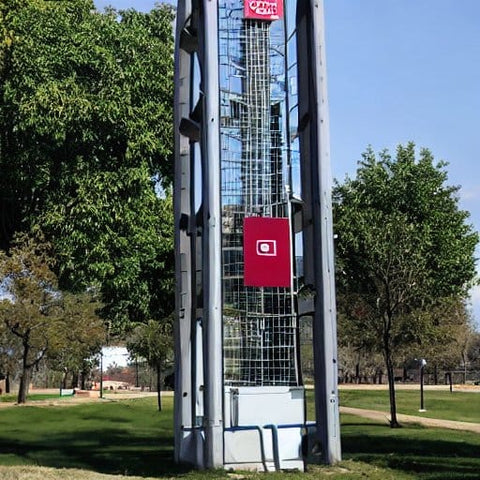What Is the Minimum Acceptable Distance Between Your Home and a 5G Cell Tower?
If you are a frequent user of a mobile phone, you may find yourself wondering how near you may go to a 5g cell tower and for how long it is safe to remain in that proximity. The fact of the matter is that when you travel farther away from mobile phone towers and Wi-Fi networks, your exposure to the radiation they emit is lowered by a substantial amount. Having stated that, despite living a close distance from a mobile phone tower, some individuals don't experience any immediate negative impacts on their health as a result of being exposed to the radiation.
Reasons to avoid being near a 5g tower:
- In comparison to earlier generations of wireless technology, 5G works at higher frequencies, which may result in a larger level of electromagnetic radiation being absorbed by the human body.
- Radiofrequency electromagnetic fields have been labeled by the World Health Organization (WHO) as having the potential to cause cancer in humans.
- There may be a connection between extended exposure to radiofrequency electromagnetic fields and an increased risk of developing neurological diseases, cancer, and other health problems, according to the findings of several research.
- People who live or work in close proximity to 5G towers may be subjected to a greater risk of radiation exposure since the 5G technology has a higher penetration strength.
- Concerns have also been raised over the possible adverse impacts that 5G technology might have on the natural world, particularly on animals and ecosystems.
Radiation exposure is significantly reduced with increasing distance
Exposure to radiation may not be all that dangerous, but it is most definitely not a stroll in the park. Millimeter waves, which are connected with 5G telecommunications, are said to have a deleterious impact on people by a number of scientists. To be more specific, they could make a person more susceptible to harmful germs, in addition to signal transduction pathways. The incidence of skin cancer may also rise as a result of these waves, which is an additional potential advantage. In point of fact, the World Health Organization (WHO) has identified this specific kind of radiofrequency (RF) radiation as being among the most significant dangers to the health of humans.
The issue is, how much is considered excessive? At this moment, the FCC permits users of mobile phones to be exposed to about four milliwatts of electricity per centimeter of body surface area for up to a period of thirty minutes. To say that this is sufficient to safeguard children or employees from the threats presented by radio waves is an understatement. On the other hand, the Environmental Working Group (EWG) points out that it is a reasonable bet to expect that the levels of exposure in a real-world situation will be lower than the ones in this research.

One of the most significant benefits of 5G is its capability to provide mobile services at higher frequencies. This translates to the fact that mobile internet may be utilized in more locations at the same time, which opens the door to a great deal of connection. Additionally, since the signals operate at a higher frequency, they are able to travel farther without any difficulty. Therefore, a network of base stations that is packed together more closely could potentially be the answer. On the other hand, it is essential to bear in mind that a more dense network can need more antennae, which is something else to take into consideration.
No concrete research have been conducted to demonstrate whether or not 5G is safe, save from the apparent watts per centimeter. Even though the FCC has a well-established standard for protecting its citizens from the dangers of wireless communication, it has not yet taken the necessary steps to update its testing guidelines to take into account the dangers posed by newer technologies. This is despite the fact that the FCC has a well-established standard.
In addition to the safety problems that have already been discussed, it is well knowledge that people have a predisposition for developing skin cancer. The skin is the biggest organ in the human body, and as such, it is involved in a wide variety of vital processes. Humans, for instance, are shielded from potentially lethal ultraviolet (UV) radiation, dangerous mechanical damage, and infectious germs. In addition to this, it serves as a barrier against the entrance of hazardous chemicals. Because of this, the skin has a wide variety of both functional and nonfunctional characteristics.
On the other hand, it is anticipated that 5G transmitters that are situated in close proximity to people would be the most successful. In order to accomplish this goal, the FCC established its exposure limitations according to the power density of the signals.
So, whats a safe distance from a 5g cell tower?
The amount of radiation energy emitted by a mobile tower reduces as the distance between them increases. In most cases, the signal is at its strongest at a distance of fifty meters from the antenna, and its strength gradually decreases as one moves farther away from the source. After the 150-meter threshold, RF energy grows weaker.
In most cases, a distance of at least a quarter of a mile (1,320 feet or 400 meters) is required to bring exposures down to the General Public Precautionary Level of 100 microwatts per meter squared (W/m2). This level is the maximum permissible level of radiation exposure for the general public. Therefore, you may assume that you are secure if there are no mobile towers at a distance of at least 400 meters from you. In addition, those who are hypersensitive to electromagnetic fields (EMF) or who have other major health problems would want to think about a considerably higher safety distance, possibly a half mile or even farther away.
Hazards of exposure to electromagnetic fields from mobile phone towers
Radio frequencies are what allow mobile phone towers to fulfill their function of providing phone coverage. We regard this kind of electromagnetic field radiation to be beneficial. Phone towers are responsible for the emission of a variety of different types of radiation, including heat and pulsed microwave waves.
In the process of persons making phone calls, radio frequency (RF) signals are sent to and from the base stations. In a subsequent step, the radio frequency (RF) waves that are generated at the base station are then sent out into the environment, where we may be subjected to them.
The amount of radiation that is emitted from a cell tower will vary depending on factors such as the kind of antennas used, the total number of antennas, the amount of time spent using the antennas, the time of day, and so on. Living in close proximity to a mobile phone tower is hazardous to one's health for a number of different reasons, the most notable of which being the radiation that it releases as well as the many health hazards that are linked with it.
Radiofrequency radiation, often known as RFR, was identified as a carcinogen by the World Health Organization (WHO) and the International Agency for Research on Cancer (IARC) in the year 2011.
Effects of mobile phone towers on one's health
Radiofrequency (RF) waves are used by cell towers, which are often referred to as base stations, in order to both receive and broadcast mobile phone signals. These waves have a relatively low level of energy when compared to the energy level of a mobile phone, and they do not have sufficient energy to cause direct damage to DNA. Despite this, their heat may nonetheless, at high enough levels, cause cancer by causing damage to the human body's tissue.
People living near 400 meters of a cell phone transmission mast had a dramatically elevated risk of acquiring cancer at a younger age, according to the findings of a research conducted in Germany. This risk was increased by a factor of three. In addition, recent studies have shown that homes that are within 300–400 meters of a cell tower may be at an increased risk for both short-term and long-term health effects. Therefore, extreme care needs to be made to construct cell towers in locations that are not near populations who are more susceptible to health risks, such as children.
There have been reports of individuals who have acquired cancer while working or living in close proximity to mobile phone towers. On the other hand, it is impossible to tell whether they are brought on by the RF waves or not. The findings of a great number of research have not provided any definitive solutions.
Exposure to radiofrequency radiation from a mobile phone has been identified as a "possible carcinogen" by the World Health Organization (WHO). This information comes from the International Agency for Research on Cancer. There have been a significant number of investigations on the possibility of a connection between the usage of mobile phones and a variety of adverse health effects. Exposure to radiofrequency radiation (RF) from a mobile phone may raise the incidence of some malignancies in lab animals, according to the findings of some of these research.
On the other hand, it is essential to keep in mind that the amount of radio frequency (RF) exposure received through a mobile phone is far lower in comparison to the amount of RF exposure received from working or living in close proximity to a cell tower. In the United States, the Federal Communication Commission and other regulating organizations decide what levels of RF and MW radiation are acceptable for humans to be exposed to. These guidelines are derived from a daily exposure time of six minutes.
The industry that deals in wireless communications is of the view that there is no consistent harm to one's health posed by RF or MW radiation. They also claim that the safety criteria for RF exposure that have been established by the National Toxicology Program are enough to safeguard public health. However, there are a number of countries on a global scale that hold the other view.
The alarming rise in the incidence of cancer in children and young people is one of the primary causes for worry surrounding mobile phone towers. This has resulted in a large number of research being conducted in a variety of nations. For instance, researchers in Taiwan evaluated the incidence of cancer in children who resided in places with above-average RF exposure and found that it was more likely for these children to get cancer. According to their findings, the overall risk of cancer was marginally increased in cities with RF exposure that was more than the median level.

Even though the ICNIRP radiation norms are supposed to limit the short-term gross heating effects of RF/MW radiation, they do not address the more significant biological effects that may come about as a result of this type of radiation. These effects could include things like cancer and birth defects. Alterations in reflexes and mood are included among them.
The International Association of Fire Fighters officially adopted a stance in opposition to the use of fire stations as mobile phone base stations in August of 2004. This statement said that the organization was against the use of fire stations for cell phone base stations. The International Association of Fire Fighters is not opposed to the use of cell towers; however, it is opposed to the installation of fire stations as cell phone base stations before it is determined whether or not there is a correlation between firefighter exposure to radiofrequency and microwave radiation and negative health effects.
Fatigue
Sleep disorders
Migraines
a heightened degree of irritation
Dizziness
Having trouble remembering things
a lack of concentration
Infections of the skin
Cardiovascular problems
Between 50 and 150 Meters Away
Difficulty concentrating due to distractions
Appetite loss Extreme discomfort
a heightened degree of irritation
Sleep disorders
Headaches
Dizziness
Nausea




















































Plusieurs effets secondaires suite à la pose de la 5G
Leave a comment